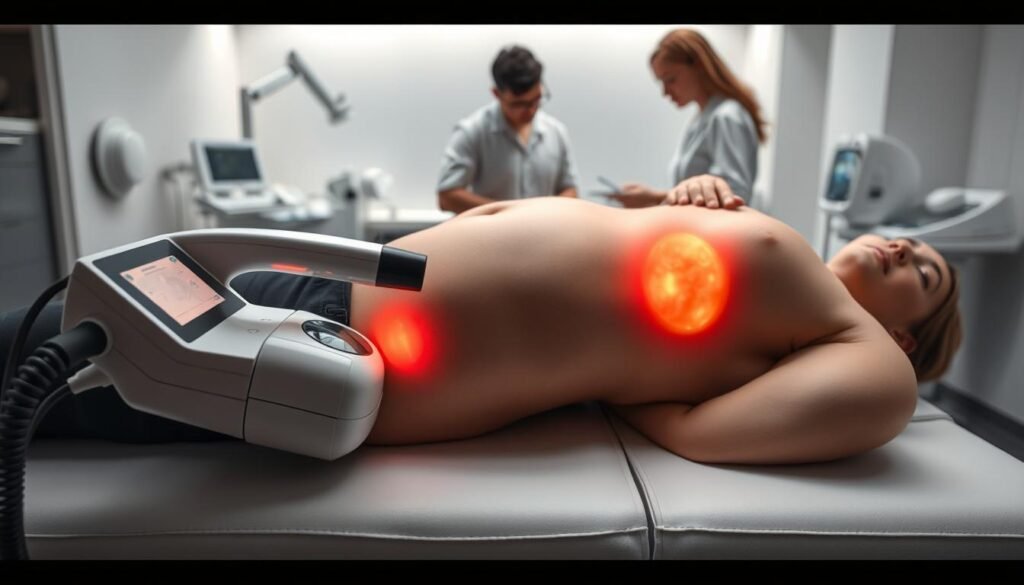Our bodies are born with a certain number of fat cells, and this number remains constant throughout our lives. When we gain weight, these cells expand, making us look heavier. Conversely, when we lose weight through diet and exercise, these cells shrink.
However, some areas of the body, like the stomach, can be particularly stubborn. Despite regular exercise and a healthy diet, fat in this area can persist. This is where non-surgical fat reduction methods come into play, offering a solution without surgery.
The good news is that there are various options available for reducing stomach fat without invasive procedures. In this article, we’ll explore these effective methods and how they can help you achieve your body goals.
Key Takeaways
- Understanding how fat cells work and why stomach fat is hard to lose.
- Exploring non-surgical methods for fat removal from stomach.
- Learning about the various options and their effectiveness.
- Discovering the costs and expected results of these methods.
- Determining the best non-surgical fat reduction method for your specific needs.
Understanding Stubborn Stomach Fat
Understanding the nature of stubborn stomach fat is crucial for those seeking effective solutions beyond conventional diet and exercise. Stubborn stomach fat refers to the fat around the abdominal area that resists reduction despite rigorous diet and exercise regimens.
This type of fat is often linked to various biological factors, including hormonal influences, genetic predispositions, and age-related metabolic changes. The persistence of stomach fat can be frustrating, but understanding its underlying causes can help in finding effective solutions.
Why Some Fat Won’t Budge with Diet and Exercise
Stubborn stomach fat often persists due to biological factors. Hormones, genetics, and age-related metabolic changes play a significant role in fat retention around the abdominal area. For instance, hormonal imbalances can affect fat distribution, while genetic factors can determine how the body stores fat.
- Biological factors contribute to the persistence of stomach fat.
- Hormonal and genetic factors influence fat storage and distribution.
- Age-related changes can slow down metabolism, leading to increased fat storage.
The Science Behind Fat Cells
The science of fat cells explains why stomach fat can be particularly resistant. Abdominal fat cells have more alpha receptors that resist breakdown compared to other body areas. Our bodies maintain a relatively constant number of fat cells throughout adulthood, but these cells can expand or shrink based on weight gain or loss.
| Characteristics of Fat Cells | Impact on Fat Reduction |
|---|---|
| Alpha receptors in abdominal fat cells | Resist breakdown, making fat reduction challenging |
| Constant number of fat cells in adulthood | Cells can expand or shrink with weight changes |
| Fat cell behavior with weight loss | Cells shrink but don’t disappear, leading to potential weight loss plateaus |
“The number of fat cells in the human body remains relatively constant in adulthood, but the size of these cells can change with weight gain or loss.”
Understanding these biological mechanisms is key to addressing stubborn stomach fat effectively. Non-surgical fat removal methods target these fat cells directly, providing a solution where diet and exercise alone are insufficient.
Can Fat Really Be Removed Without Surgery?
Advances in technology have made it possible to target and eliminate fat cells without the need for surgical intervention. Non-surgical fat removal methods have gained popularity for their effectiveness in reducing stubborn fat. These treatments target fat cells through various mechanisms, including freezing, heating, ultrasound waves, or light energy, without requiring incisions or anesthesia.
How Non-Surgical Fat Removal Works
Non-surgical fat removal technologies work by causing controlled damage to fat cells, leaving surrounding tissues unharmed. This damage triggers the body’s natural processes to eliminate the damaged cells. The result is a reduction in fat in the treated area. Most patients see gradual improvement over 1-3 months as the body processes and eliminates the damaged fat cells.
Permanence of Results
Although non-surgical fat removal can significantly reduce fat cells, maintaining a stable weight is crucial for the permanence of the results. Remaining fat cells can still expand with significant weight gain. A healthy lifestyle is essential to maintaining the results. According to experts, non-surgical fat removal can reduce fat cells by 20-25% in the treated area.
| Treatment Method | Mechanism | Effectiveness |
|---|---|---|
| CoolSculpting | Freezing | 20-25% fat reduction |
| SculpSure | Laser Heating | 20-25% fat reduction |
| Ultrasound Fat Reduction | Ultrasound Waves | Variable, dependent on treatment |
“Non-surgical fat removal has revolutionized the way we approach body contouring, offering a safer and less invasive alternative to traditional surgical methods.”
Top Non Surgical Fat Removal from Stomach Methods
The quest for a slimmer stomach has led many to explore non-invasive fat reduction treatments that don’t require going under the knife. Non-surgical fat removal methods have become increasingly popular due to their effectiveness and lower risk compared to surgical procedures.
Overview of Available Options
Several non-surgical fat removal methods are available for reducing stomach fat. These include cryolipolysis (CoolSculpting), laser treatments (SculpSure), radiofrequency treatments, ultrasound therapy, and red light therapy. Each of these treatments works through different mechanisms to break down fat deposits.
- Cryolipolysis freezes fat cells, leading to their gradual removal.
- Laser treatments heat fat cells, causing their destruction.
- Ultrasound therapy uses sound waves to disrupt fat cell walls.
- Red light therapy employs specific wavelengths to target fat cells.
Comparing Effectiveness for Stomach Fat
When comparing these methods, several factors come into play, including effectiveness, treatment time, number of sessions required, discomfort level, recovery time, and cost. CoolSculpting is often considered the gold standard for non-surgical stomach fat reduction, with clinical studies showing an average fat reduction of 20-25% in treated areas.
| Treatment | Effectiveness | Number of Sessions | Recovery Time |
|---|---|---|---|
| CoolSculpting | 20-25% fat reduction | 1-3 sessions | Minimal downtime |
| SculpSure | Up to 24% fat reduction | 1 session | No downtime |
| Ultrasound Therapy | Variable results | Multiple sessions | Minimal downtime |
As shown in the table, each treatment has its advantages and considerations. It’s essential to consult with a healthcare professional to determine the best option for individual needs.
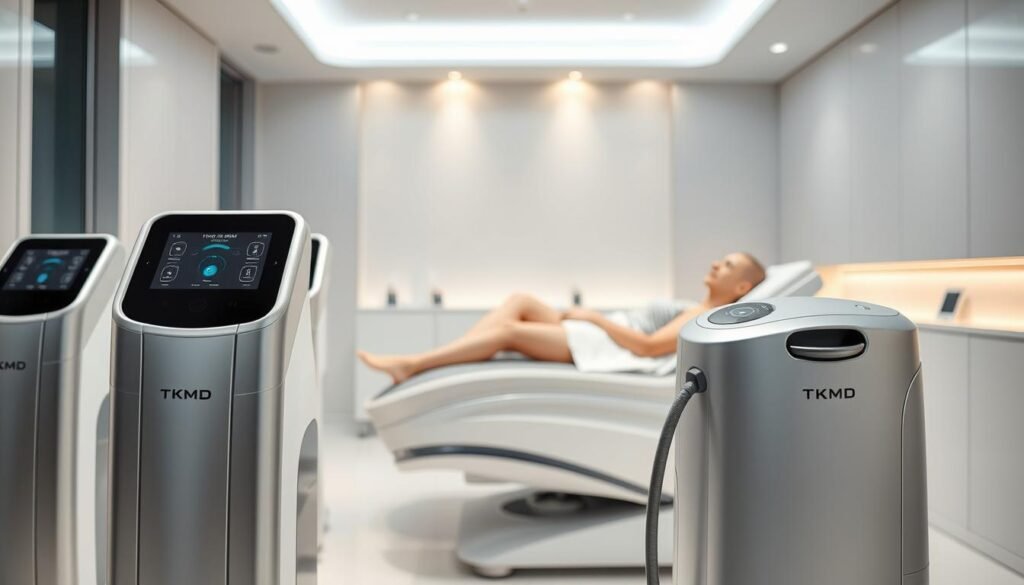
CoolSculpting: Freezing Away Fat Cells
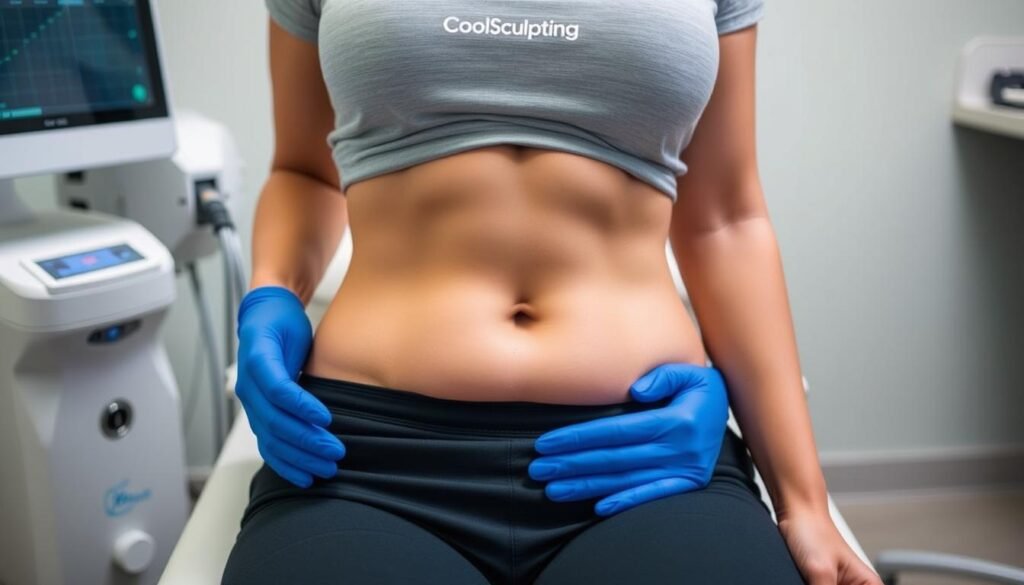
CoolSculpting has emerged as a leading non-surgical fat removal method, particularly for targeting stubborn stomach fat. This treatment uses controlled cooling, also known as cryolipolysis, to freeze and eliminate fat cells in the targeted area.
How CoolSculpting Works
CoolSculpting is a safe and effective procedure that destroys fat cells without damaging the surrounding tissues. During the treatment, a gel pad is applied to the targeted area to protect the skin, followed by the use of a vacuum-like applicator that draws the tissue into the cooling panels. This process effectively reduces fat in the treated area.
Expected Results and Timeline
Most patients require two treatment sessions spaced approximately eight weeks apart. Results from CoolSculpting develop gradually as the body eliminates the destroyed fat cells. Initial changes can be visible within three weeks, with optimal results appearing two to three months after the final treatment.
Cost and Treatment Sessions
The cost of CoolSculpting for stomach fat typically ranges from $2,000 to $5,000 for a complete treatment plan. Factors affecting the price include geographic location, provider expertise, and the number of applications needed. It’s essential to consult with a qualified provider to determine the best treatment plan and associated costs.
Laser Fat Reduction Treatments
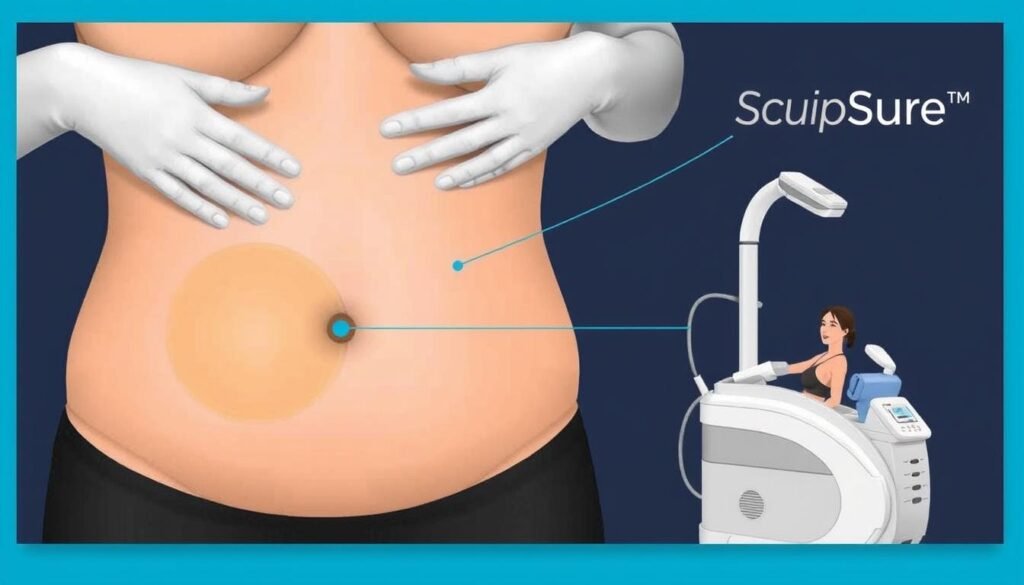
For those seeking a non-surgical solution to stubborn stomach fat, laser fat reduction treatments offer a promising option. These treatments utilize controlled heat energy to target and break down fat cells in the stomach area.
SculpSure and Other Laser Options
Laser fat reduction treatments like SculpSure use a laser to heat fat cells to approximately 107°F (42°C), causing them to rupture and be naturally eliminated by the body’s lymphatic system. Unlike CoolSculpting, which freezes fat, SculpSure and similar treatments provide an alternative method for fat reduction. SculpSure treatments are typically 25 minutes per session, with most patients requiring 1-3 sessions spaced 6 weeks apart to achieve optimal results.
Benefits and Limitations for Stomach Fat
The benefits of laser fat reduction include shorter treatment times and the ability to treat multiple areas simultaneously, with minimal discomfort described as a warming sensation. However, limitations include potential variability in results based on skin type and fat composition. Laser treatments may be less effective for very dense or fibrous fat deposits in the stomach area. Understanding these factors is crucial for managing expectations and achieving satisfactory fat reduction results.
Ultrasound Fat Reduction Therapy
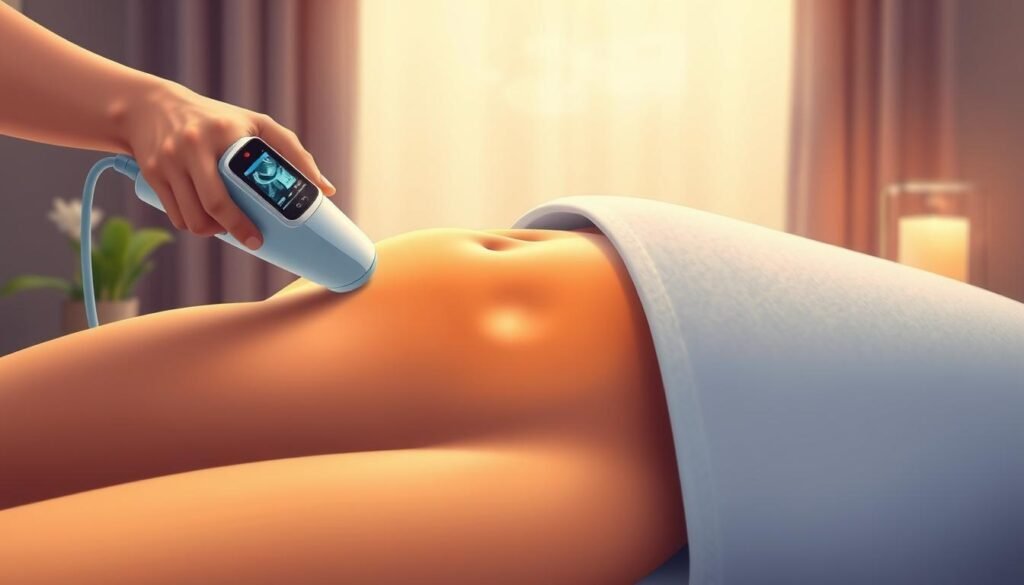
Ultrasound fat reduction therapy has emerged as a promising non-surgical solution for individuals seeking to reduce stubborn stomach fat. This treatment utilizes focused sonic waves to target fat cells, providing a non-invasive alternative to surgical fat removal methods.
How Ultrasound Targets Fat Cells
Ultrasound fat reduction therapy works by using high-frequency sound waves to create a mechanical disruption of fat cell membranes. This process causes the fat cells to break down and release their contents, which are then naturally metabolized by the body. The technology behind ultrasound treatments, such as UltraShape and Liposonix, ensures that the surrounding tissues, including blood vessels, nerves, and skin, remain unaffected.
The selective targeting of fat cells makes ultrasound therapy an effective fat reduction treatment, particularly for the abdominal area. By focusing on the fat cells without damaging the surrounding tissue, there’s minimal risk of bruising or swelling following the treatment.
Treatment Process and Results
Most patients require a series of three treatments spaced approximately two weeks apart, with each session lasting between 30-60 minutes, depending on the size of the treatment area. The gradual breakdown of fat cells allows for a natural-looking reduction in fat, with initial improvements visible within two weeks and final results appearing within 2-4 months after the treatment series.
The ultrasound technology ensures a safe and effective non-surgical fat reduction method, making it an attractive option for those seeking to avoid invasive procedures. By understanding the process and expected outcomes, individuals can make informed decisions about their fat reduction treatment options.
Red Light Therapy for Fat Reduction
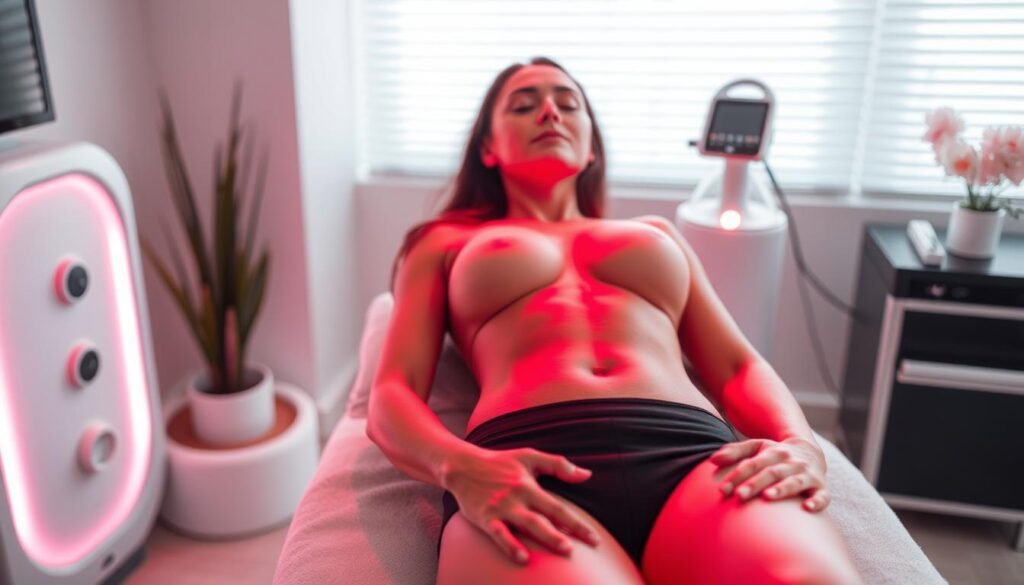
Non-surgical fat reduction has a new contender: red light therapy. This innovative treatment uses specific wavelengths of red light to target and reduce fat cells in the body, particularly in areas like the stomach.
Science Behind Light-Based Fat Removal
Red light therapy, or photobiomodulation, employs red light wavelengths, typically between 630-660 nanometers, to penetrate the skin and create temporary pores in fat cell membranes. This process allows the fat cells to release their contents without being destroyed, making the results dependent on maintaining a stable weight.
Effectiveness and Treatment Protocol
The released fat is processed by the lymphatic system and eliminated through natural metabolic processes. Treatment protocols typically involve 2-3 sessions per week for 4-6 weeks, with each session lasting approximately 20-30 minutes and requiring no downtime. Red light therapy also offers the added benefit of skin tightening and improved texture due to increased collagen production.
With red light therapy, patients can achieve measurable reductions in waist circumference and improved body contours. Maintaining a healthy lifestyle is crucial to sustaining the results.
Radiofrequency Treatments
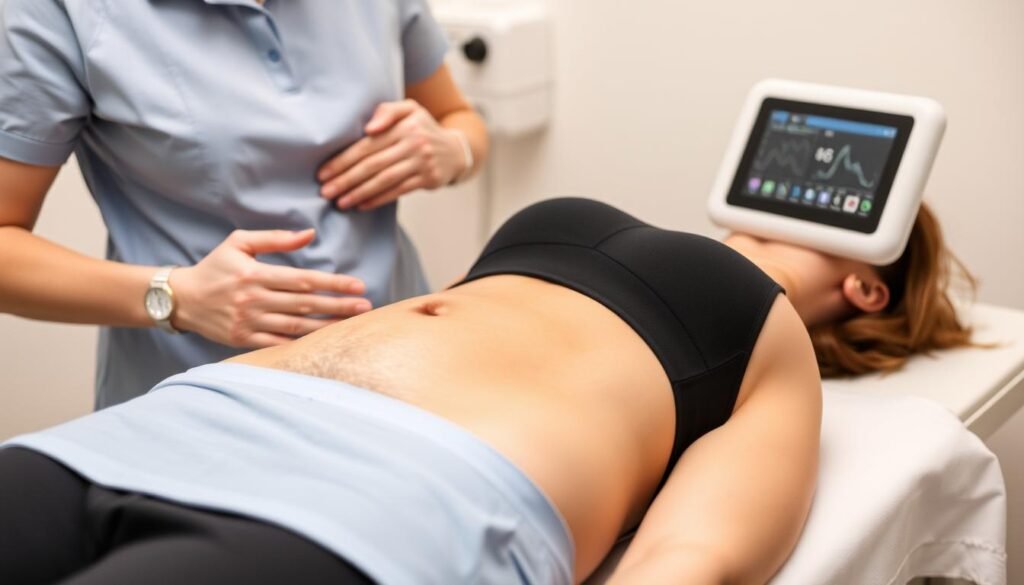
Radiofrequency treatments have emerged as a popular method for non-surgical fat reduction, particularly for targeting stubborn stomach fat. This technology utilizes electromagnetic energy to heat fat cells, causing them to break down while stimulating collagen production in surrounding tissues.
How RF Energy Melts Fat
Radiofrequency (RF) treatments use electromagnetic energy to heat fat cells to approximately 110-115°F (43-46°C), leading to their breakdown. The RF energy selectively targets fat cells because they have higher water content and less resistance than other tissues, allowing the treatment to effectively “melt” fat without damaging skin or muscle. Popular RF treatments for stomach fat include Vanquish, Venus Legacy, and TruSculpt.
Ideal Candidates and Results
Ideal candidates for RF treatments are those within 10-15 pounds of their goal weight with moderate fat deposits and good skin elasticity. RF treatments provide both fat reduction and skin tightening benefits. Most patients require 4-6 weekly treatments lasting 30-45 minutes each, with gradual results appearing over 2-3 months as the body eliminates the damaged fat cells. Permanent results are visible two months after the final treatment.
Advanced Options: Emsculpt Neo and ThermaLipo
Emsculpt Neo and ThermaLipo represent the latest advancements in non-surgical fat removal and body sculpting. These treatments offer a more comprehensive approach to body transformation by addressing multiple aesthetic concerns simultaneously.
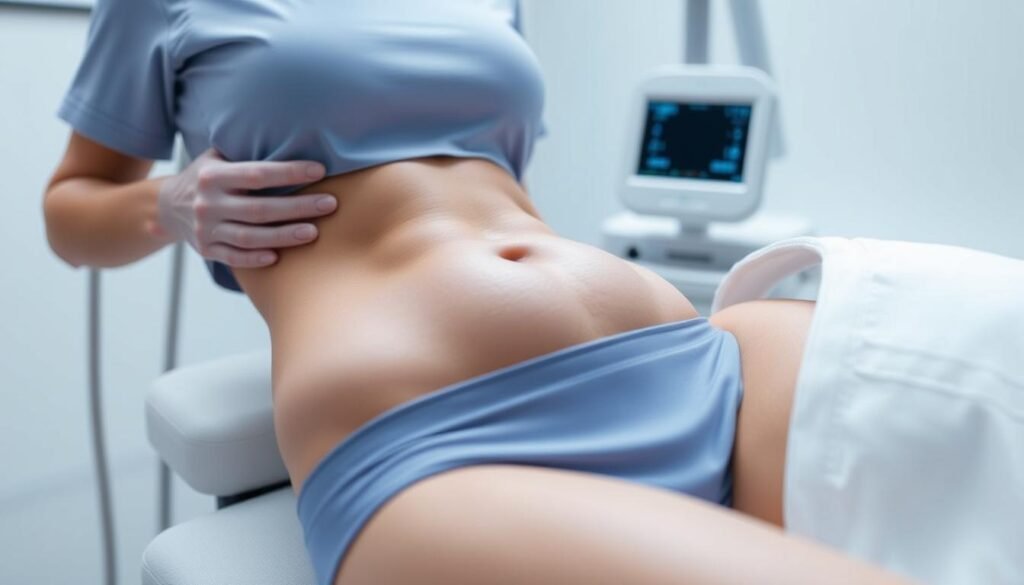
Combining Fat Reduction with Muscle Toning
Emsculpt Neo combines High-Intensity Focused Electromagnetic (HIFE) technology with radiofrequency to build muscle and reduce fat in the abdominal area. This dual-action approach not only melts away fat but also tones the muscle and tightens the skin, offering a more comprehensive body transformation. For more information on how Emsculpt Neo works, you can explore further.
Who Benefits Most from These Treatments
These advanced options are particularly beneficial for individuals who have achieved good weight management but desire more definition, muscle tone, and skin tightening in addition to fat reduction. They are ideal for those looking for a non-surgical solution to improve body contours without the need for invasive procedures. To understand the specifics of ThermaLipo, visit https://www.carecredit.com/well-u/health-wellness/how-thermalipo-works/ for detailed insights.
What to Expect During Non-Surgical Fat Removal
When considering non-surgical fat removal, understanding the process from start to finish is crucial for managing expectations. Non-surgical fat reduction treatments offer a range of benefits, including minimal downtime and fewer side effects compared to surgical alternatives.
Pre-Treatment Preparation
Before undergoing non-surgical fat removal, patients typically have a consultation to assess their candidacy and create a personalized treatment plan. Pre-treatment preparation may include avoiding blood thinners and maintaining hydration. Some procedures might require shaving the treatment area or avoiding sun exposure.
During the Procedure
During the non-surgical fat reduction procedure, patients may experience varying sensations based on the technology used, such as cooling, warmth, or tingling. Most treatments take between 25-60 minutes per area, allowing patients to relax, read, or work on their laptops.
Post-Treatment Recovery
Post-treatment recovery is typically minimal, with most patients resuming normal activities immediately. Temporary side effects may include redness, swelling, bruising, tenderness, or numbness, which usually resolve within days to weeks. 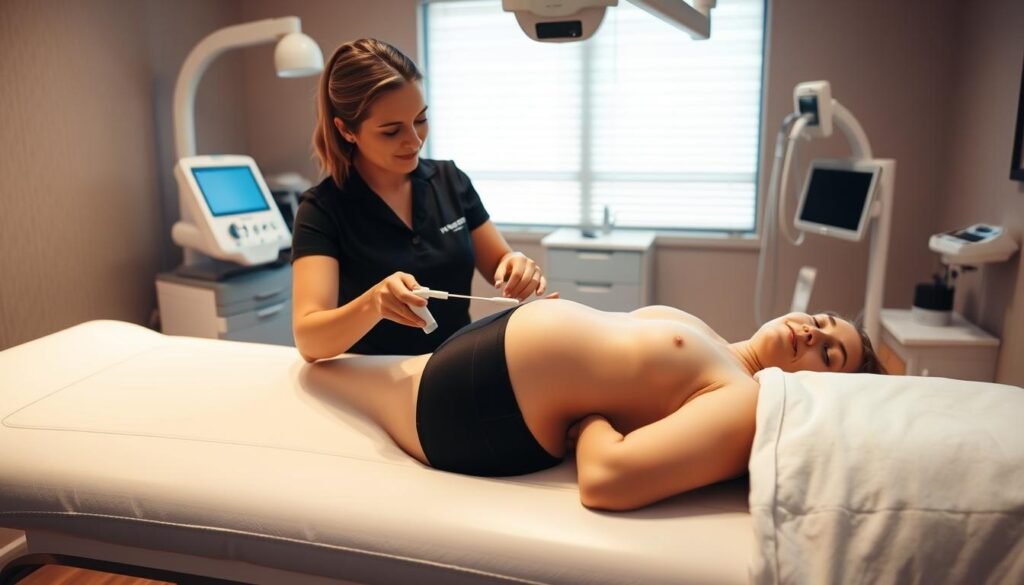
Potential Side Effects and Safety Considerations
Non-surgical fat removal treatments are not without risks, and being informed about possible side effects is essential. While these treatments are generally considered safe, understanding the potential risks can help patients make informed decisions about their care.
Common Side Effects
Common side effects of non-surgical fat removal treatments are typically mild and temporary, including redness, swelling, bruising, tenderness, numbness, and tingling in the treated area. Some treatments may have more specific side effects; for example, CoolSculpting can cause “paradoxical adipose hyperplasia” (tissue hardening) in rare cases, while heat-based treatments might lead to temporary skin discoloration.
- Redness and swelling
- Bruising and tenderness
- Numbness and tingling
- Temporary skin sensitivity
When to Consult a Doctor
While most side effects resolve within days to weeks, patients should consult a doctor immediately if they experience severe pain, extensive swelling, blistering, skin discoloration that doesn’t resolve, signs of infection, or any symptoms that worsen over time. Serious complications, although rare, can include burns, nerve damage, uneven fat removal, or infection, highlighting the importance of choosing a qualified provider with proper training and equipment.
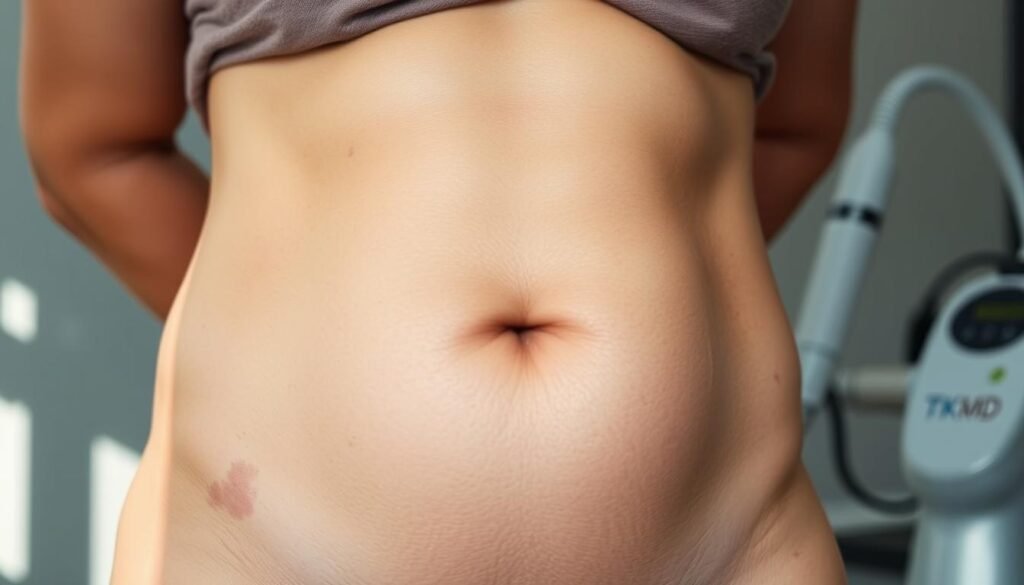
How to Choose the Right Non-Surgical Fat Removal Method
Selecting the ideal non-surgical fat removal method requires a thorough understanding of your personal goals and body needs. Different treatments offer various benefits, so it’s essential to choose one that aligns with your specific requirements.
Factors to Consider
When choosing a non-surgical fat reduction method, several factors come into play. These include your specific body concerns, the amount of fat you wish to reduce, your budget, the time you have available for treatments and recovery, and your expectations for results.
The ideal treatment varies based on factors like the thickness of your fat layer, skin laxity, and whether you desire additional benefits such as muscle toning or skin tightening alongside fat reduction.
Questions to Ask Your Provider
It’s crucial to ask the right questions when consulting with a provider. Inquire about their experience with specific treatments, request before and after photos of actual patients, and understand the expected number of sessions needed, total cost, and potential side effects specific to your situation.
Also, consider asking about the provider’s training and certification with the specific technology, as proper application significantly impacts both results and safety.
| Treatment | Benefits | Potential Side Effects | Cost |
|---|---|---|---|
| CoolSculpting | Effective fat reduction, non-invasive | Temporary redness, swelling | $600-$1,500 per session |
| Laser Fat Reduction | Targets fat cells, stimulates collagen | Mild discomfort, redness | $200-$1,000 per session |
| Ultrasound Fat Reduction | Non-invasive, targets deep fat layers | Rarely, redness or bruising | $500-$2,000 per session |
Conclusion
Effective non-surgical fat reduction is now within reach, thanks to cutting-edge technologies. Various treatments offer scientifically proven results for patients seeking body contouring without surgery. The most effective treatments, including CoolSculpting, laser treatments, ultrasound therapy, radiofrequency, and red light therapy, each provide unique advantages depending on the patient’s specific body composition and aesthetic goals.
Results from these treatments typically develop over weeks to months as the body naturally processes and eliminates the targeted fat cells. For long-term success, these treatments should be viewed as complementary to healthy lifestyle habits. Significant weight gain can still expand remaining fat cells in the treated areas. When choosing a provider for non-surgical fat removal, patients should prioritize experience, proper certification, and a thorough consultation process to ensure safe, effective treatment tailored to their unique body and goals.
By understanding the available non-surgical fat reduction options and maintaining realistic expectations, individuals can achieve their desired body shape without invasive procedures. As technology continues to advance, combination treatments like Emsculpt Neo represent the future of non-surgical body contouring, offering more comprehensive results with minimal downtime.

